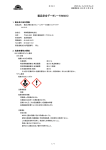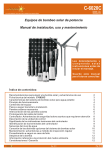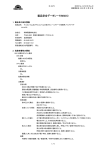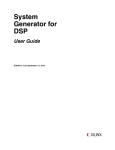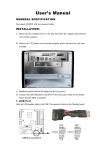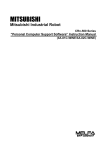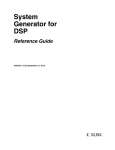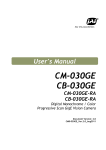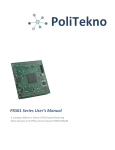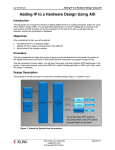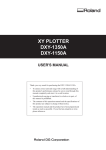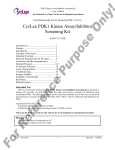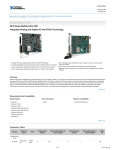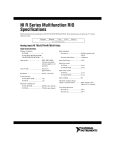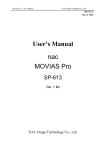Download (TKDN-SP6-16/45) Hardware manual
Transcript
TOKUDEN Spartan-6 Evalutaion Board (TKDN-SP6-16/45) Hardware manual Rev 3 August 10, 2010 Tokushu Denshi Kairo Inc. 特電 TOKUDEN Notes For safety using, please note the operating suggestions listed below. Failure to use caution may lead to personal injury, fire, or property damage. 1. Take care not to damage, shock or be injured in touching the current-carrying device. 2. When this product is inserted with wrong direction, it may have a serious damage. Inserting and removing should be done under the power off. 3. Take care not to make impact, heating, or vibrate hardly. 4. When some trouble has found, power off and check the board. This product is intended for education, preproduction and testing the FPGA’s behavior, so that Tokushi Denshi Kairo Inc. assumes no responsibility for any results from other usage, and couldn’t be applied to following high-risk application without written pre-permission. 1. Instruments associated with human life. 2. Medical Equipment 3. Instruments which may affect natural environment, someone’s health or belonging adversely by malfunction. 4. Instruments which may cause fire hazard by malfunction. 5. Aerospace instrument, and navigation system 6. Tactical weapon system, manufacture system or their helping system for military purposes. 7. Instruments rerated nuclear power. 8. Electric power tools. 9. Other instruments which may cause some trouble and damage by occurring malfunction or loss of data. 1 ©Copyright 2009 特殊電子回路㈱ All rights reserved. 特電 TOKUDEN Index Introduction................................................エラー! ブックマークが定義されていません。 Chapter 1 Overview.......................................................................................................... 4 1.1 Overview.................................................................................................................. 4 1.2 Functional Description ........................................................................................... 4 1.3 Hardware Requirements......................................................................................... 5 Chapter 2 Setup................................................................................................................ 6 2.1 Connector Attachment ............................................................................................ 6 2.2 Power Supply........................................................................................................... 6 2.3 Jumper Setting........................................................................................................ 7 Chapter 3 Configuring the FPGA .................................................................................... 8 3.1 How to Configure .................................................................................................... 8 3.2 Using USB Cable..................................................................................................... 9 3.3 Using Other JTAG Cable ...................................................................................... 10 3.4 Reconfigure FPGA................................................................................................. 10 Chapter 4 DDR2-SDRAM............................................................................................... 11 Chapter 5 Connectors and I/O Features........................................................................ 12 5.1 CN1 (40pin Extender).................................................................................... 12 5.2 CN2 (40pin Extender).................................................................................... 13 5.3 CN5 (for SPI Writing) .................................................................................... 14 5.4 LEDs, Switch, Cristal Oscillator .......................................................................... 14 Chapter 6 Support .......................................................................................................... 15 2 ©Copyright 2009 特殊電子回路㈱ All rights reserved. 特電 TOKUDEN Introduction Thank you for purchasing TOKUDEN Spartan-6 Evaluation Board (TKDN-SP6-16/45). This product helps you a lot to develop your original control device using XILINX’s newest FPGA ,Spartan-6. Notice 1.This paper and product’s specification may change without preliminary announce because of its improvement. 2.Tokusyu Denshi Kairo Inc. put the maximum effort into making this product, but if you have detect some problem, please contact us. 3.Tokusyu Denshi Kairo Inc. assumes no responsibility for any results from whatever usage. Components This package includes : Tokuden Spartan-6 Evaluation Board 1 Accessories Pinheader (40 pin) 2 DC Power Jack 1 This board requires MiniB USB cable to configure FPGA by JTAG. You need not to prepare JTAG cable. 3 ©Copyright 2009 特殊電子回路㈱ All rights reserved. 特電 TOKUDEN Chapter 1 1.1 Overview Overview Tokuden Spartan-6 Evaluation Board (TKDN-SP6-16/45) is an evaluation board to evaluate Spartan-6 easily which is the newest FPGA of XILINX. Figure 1 Top View of the TKDN-SP6-16/45 1.2 Features This product has the following features. It carries large-scale FPGA TKDN-SP6-16 Spartan-6 XC6SLX16-CSG324 14,579 logic cells, 32 DSP48 slices and 32 18kB Block RAMs TKDN-SP6-45 Spartan-6 XC6SLX45-CSG324 43,661 logic cells, 58 DSP48 slices and 116 18kB Block RAMs DDR2 SDRAM HYB18T512800BF-2.5 (Quimonda company) 512Mbit (64M word 8bit width, 4 banks) . Maximum data rate 400MHz. Cypress Semiconductor EZ-USB FX2LP(CY7C68013A) Put together the application-transfer and USB-JTAG function into only one USB port. Maximum Effective Transfer Speed ・IN : about 40MBytes/sec ・OUT : about 30MBytes/sec *It depends on your PC specification. 4 ©Copyright 2009 特殊電子回路㈱ All rights reserved. 特電 TOKUDEN 64 user I/Os: Easy-extending 2.54mm pitch pinheader FPGA Configuration from Onboard SPI ROM ATMEL SPI Flash Memory :AT45DB161D (16Mbit memory) It can storage FPGA configuration data (about 4Mbit) and user data. *Another company’s memory IC may be applied depend on the product availability. On Board LED Display and Push Switch On Board Cristal Oscillator(50MHz) 1.3 Hardware Requirements Table 1 Hardware Requirements Item PC Condition PC/AT compatible machine ISE11.3 or later is necessary for logic synthesis OS Windows2000/XP/7/Vista(32bit edition) (USB device driver doesn’t support 64bit edition.) CPU Pentium III 800MHz or faster processor (recommended) 5 ©Copyright 2009 特殊電子回路㈱ All rights reserved. 特電 TOKUDEN Chapter 2 2.1 Setup Connector Attachment This product contains following parts. DC Power Jack 1 … for CN3 Pinheader (40 pin) 2 for CN1,CN2 … Attach them on demand. 2.2 Power Supply The main source of power is one of the following four ways. ① From USB Short J1, and the board becomes USB-supply mode. This supply line contains 500mA resettable fuse, so this board’s maximum consumption current is 500mA. When you use another power supply, you must not short J1. ② From AC adapter Attach DC power Jack to CN3, and supply 5V DC with AC adapter. ③ From pinheader (5V) Supply 5V from CN6 which is located on the underside of DC power jack. ④ From pinheader(3.3V) Supply 3.3V from CN1-17th pin,CN1-18th pin,CN1-29th pin,CN1-30th pin. 6 ©Copyright 2009 特殊電子回路㈱ All rights reserved. 特電 TOKUDEN 2.3 Jumper Setting This board has three jumper, J1,J2,J3. J2 and J3 is recommended to short. J1 is connected as necessary. J3 J1 J2 Figure 2 Jumper’s position Table 2 Description of Jumper Number Function J1 J1 enables USB-supply mode. In case that the board’s consumption current exceeds 500mA or the board is supplied from 5V AC adapter, open J1. J2 J2 enables the USB setting data. It is used for restoring in the case of writing failure of USB setting data. J2 is recommended to short in normal use. J3 J3 connects CN2 to 3.3V power supply. Choise short or open depend on your basebord’s usage. 7 ©Copyright 2009 特殊電子回路㈱ All rights reserved. 特電 TOKUDEN Chapter 3 3.1 Configuring the FPGA How to Configure FPGA is volatile (its data is deleted by power off), so it should be configured in some way. There are two configuration ways. First is configuring FPGA directory, and second is writing the configuration data to the serial flash ROM. See Table 3. Table 3 Configuration ways Feature Direct configure Serial Flash ROM volatile/nonvolatile volatile nonvolatile Configuration time Fast (about 5 second ) Late (about 1 minute) Tokuden’s freeware(sp6jtag.exe) Tokuden’s freeware(sp6jtag.exe) MITOUJTAG MITOUJTAG *XILINX iMPACT can also. *XILINX iMPACT can also. Testing Operate standalone Configuration tool Main Purpose After you wrote configuration data to serial flash ROM, it works immediately on power on. However, it takes long times to write the data to serial flash ROM, so it is suitable for standalone operating. When you configure FPGA directory, configuration time is short and it is suitable for prototype developing, although the configuration data is erase when the power is turned off. 8 ©Copyright 2009 特殊電子回路㈱ All rights reserved. 特電 TOKUDEN 3.2 Using USB Cable On-board USB-JTAG writing is the best way to configure FPGA. (JTAG is the IC testing standard and also be utilized as FPGA configuration.) 1. Get the free configuration tool ‘SP6JTAG.exe’ from our Web site. http://www.tokudenkairo.co.jp/sp6en/ 2. Connect the PC and board’s USB connector via MiniB USB Cable. 3. Boot MS-DOS prompt and type following command. sp6jtag.exe ‒autofilename.bit Configuration will be done in about 3 seconds. Figure 3(a) Connect via USB Figure 3(b) Configuration with SP6JTAG SP6JTAG also supports writing to SPI Flash ROM. For SPI Flash ROM writing, type following command. sp6jtag.exe ‒spi ‒autofilename.bit Writing will be done in about 30 seconds. You don’t need to convert bit stream file to MCS file. Write it as it is. 9 ©Copyright 2009 特殊電子回路㈱ All rights reserved. 特電 TOKUDEN 3.3 Using Other JTAG Cable Other JTAG cable is available at CN2, which is placed at the upper left side of the board. Connect the board pins V, C, I, M, O, G to fry lead wire Vref, TCK, TDI, TMS, TDO, GND. See board’s silk and Figure 4. When J3 is shorted, 3.3V power is supplied from CN2. Figure 4 JTAG connetion And write BitStream file (.bit) to FPGA with MITOUJTAG, J-Writer or iMPACT and so on. 3.4 Reconfigure FPGA To reconfigure FPGA, push red switch (SW2) which lead FPGA’s PROGRAM pin falls to Low, and the FPGA is reconfigured. *In reconfiguration, all I/Os are high impedance. *If any configuration data has already written to SPI ROM, the data will boot. Figure 5 Reset Switch 10 ©Copyright 2009 特殊電子回路㈱ All rights reserved. 特電 TOKUDEN Chapter 4 DDR2-SDRAM Quimonda DDR2 SDRAM is on board. Memory size is 512Mbit, data bus width, which connects to FPGA, is 8bit, and maximum clock frequency is 400MHz. Connection to FPGA and SDRAM is shown in Table 4. These signals are SSTL-18 interface. These pins can be accessed with Memory Controller Block(MCB) embedded in Spartan-6. Table 4 Connection between DDR2 SDRAM and FPGA DDR2 Pin name FPGA Pin function number FPGA DDR2 Pin Pin name function number A0 H15 D0 M16 A1 H16 D1 M18 A2 F18 D2 L17 A3 J13 D3 L18 A4 E18 D4 H17 A5 L12 D5 H18 A6 L13 D6 J16 A7 F17 D7 J18 A8 H12 DQSp K17 A9 G13 DQSn K18 A10 E16 RAS K15 A11 G14 CAS K16 SDRAM A12 D18 WEN K12 Control signal A13 C17 CS BA0 H13 ODT Address Bus H14 CKp G16 CKn G18 Data strobe K14 Bank address BA1 Data Bus Terminating Resistor ON/OFF Clock DM L16 Data mask CKE D17 Clock Enable 11 ©Copyright 2009 特殊電子回路㈱ All rights reserved. 特電 TOKUDEN Chapter 5 5.1 Connectors and I/O Features CN1(40pin Extender) CN1 is the user connecter located on board’s under side. 36 general purpose I/O(GPIO) are available. Table 5 shows the pin assign. Table 5 CN1 pin assign Pin FPGA number Pin number 1 P3 3 Pin FPGA number Pin number GPIO(B0) 2 N4 GPIO(B1) P4 GPIO(B2) 4 N3 GPIO(B3) 5 N5 GPIO(B4) 6 V4 GPIO(B5) 7 T3 GPIO(B6) 8 T4 GPIO(B7) 9 R3 GPIO(B8) 10 T8 GPIO(B9) 11 R8 GPIO(B10) 12 T11 GPIO(B11) 13 T9 GPIO(B12) 14 R11 GPIO(B13) 15 P11 GPIO(B14) 16 N10 GPIO(B15) 3.3V Power 18 17 Function Function 3.3V Power 19 U5 GPIO(B16) 20 V5 GPIO(B17) 21 T5 GPIO(B18) 22 U7 GPIO(B19) 23 V7 GPIO(B20) 24 U8 GPIO(B21) 25 V8 GPIO(B22) 26 V9 GPIO(B23) GND 28 27 GND 29 U10 GPIO(B24) 30 V10 GPIO(B25) 31 V11 GPIO(B26) 32 U11 GPIO(B27) 33 U13 GPIO(B28) 34 V13 GPIO(B29) 35 U15 GPIO(B30) 36 V15 GPIO(B31) 37 U16 GPIO(B32) 38 V16 GPIO(B33) 39 R10 GPIO(B34) 40 T10 GPIO(B35) 12 ©Copyright 2009 特殊電子回路㈱ All rights reserved. 特電 TOKUDEN 5.2 CN2(40pin Extender) CN2 is the user connecter located on board’s upper side. 28 general purpose I/O(GPIO) and signals associated in FPGA configuration are available. Table 6 shows the pin assign. Table 6 CN2 pin assign Pin FPGA number Pin number 1 V17 Function Pin FPGA number Pin number DONE 2 Function 3.3V Power (on demand) 3 B18 JTAG signal(TMS) 4 V2 5 A17 JTAG signal(TCK) 6 D16 JTAG signal(TDO) GND 8 D15 JTAG signal(TDI) 7 PROGRAM_B 9 C6 GPIO(A0) 10 B2 GPIO(A1) 11 B3 GPIO(A2) 12 A2 GPIO(A3) 13 B4 GPIO(A4) 14 A3 GPIO(A5) 15 C5 GPIO(A6) 16 A4 GPIO(A7) 17 B6 GPIO(A8) 18 A5 GPIO(A9) GND 20 19 GND 21 C7 GPIO(A10) 22 A6 GPIO(A11) 23 D8 GPIO(A12) 24 C8 GPIO(A13) 25 C10 GPIO(A14) 26 A10 GPIO(A15) 27 A11 GPIO(A16) 28 B11 GPIO(A17) 3.3V Power 30 29 3.3V Power 31 A12 GPIO(A18) 32 B12 GPIO(A19) 33 A13 GPIO(A20) 34 C13 GPIO(A21) 35 A14 GPIO(A22) 36 B14 GPIO(A23) 37 A15 GPIO(A24) 38 C15 GPIO(A25) 39 A16 GPIO(A26) 40 B16 GPIO(A27) 13 ©Copyright 2009 特殊電子回路㈱ All rights reserved. 特電 TOKUDEN 5.3 CN5(for SPI Writing) CN5 is used as SPI writing. It is done by sending SPI signal to CN5 using XILINX JTAG cable and so on. (But it is not recommended.) Table 7 CN5 pin assign Pin Name number 5.4 FPGA Function Pin number 1 Vref 3.3V Reference Output 2 CCLK R15 Configuration Clock 3 MOSI T13 SPI Data Output 4 CS V3 SPI Selector 5 MISO R13 Configuration Data Input 6 GND GND LEDs, Switch, Cristal Oscillator Table 8 shows a on-board component’s pin assign. Table 8 SPI LEDs, Switch, Cristal Oscillator Name FPGA function Pin number LED0 F13 LED0 lights up at H level. LED1 C11 LED1 lights up at H level. LED2 C9 LED2 lights up at H level. LED3 A9 LED3 lights up at H level. LED4 B9 LED4 lights up at H level. LED5 A8 LED5 lights up at H level. LED6 B8 LED6 lights up at H level. LED7 A7 LED7 lights up at H level. Switch D6 Cristal Oscillator D11 When SW1 is pushed, H level signal is input. 50MHz Clock. 14 ©Copyright 2009 特殊電子回路㈱ All rights reserved. 特電 TOKUDEN Chapter 6 Support Support Additional information, reference, device driver, sample application, newest IP-Core is provided at following URL. http://www.tokudenkairo.co.jp/sp6brd.html About “JTAG-HIROBA” JTAG-HIROBA is a community among only our product’s user. It is intended to provide support, technical information and to fix bug. You can get secret information which is not published on Web. Join it now ! http://www.tokudenkairo.co.jp/jtag/sns.html Tokuden Spartan-6 Evaluation Board Rev 3 User Manual August 5, 2010 Tokusyu Denshi Kairo inc. ©Copyright 2010 Tokusyu Denshi Kairo inc. All rights reserved. 15 ©Copyright 2009 特殊電子回路㈱ All rights reserved.


















